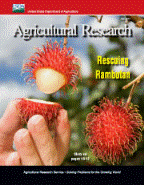United States Department of Agriculture: Agricultural Research Service, Lincoln, Nebraska

Agricultural Research Magazine
Date of this Version
7-2013
Document Type
Article
Citation
Agricultural Research July 2013
Abstract
Determining how much time animals spend eating could help animal caretakers identify sick livestock, improve management, and establish genetic differences within a herd. But first, a system is needed to monitor animal feeding behavior.
Scientists at the Agricultural Research Service’s Roman L. Hruska U.S. Meat Animal Research Center in Clay Center, Nebraska, have developed a new system to monitor feeding behavior of feedlot cattle and grow-finish swine in a livestock industry setting.
The system, created by agricultural engineers Tami Brown-Brandl and Roger Eigenberg in the center’s Environmental Management Research Unit, uses standard radio-frequency identification technology designed around a commercial reader. The technology includes an ear tag applied to each animal, monitoring equipment at the feeders, and data recording and storage.
Eigenberg designed the hardware for the system, including a “multiplexer.” Instead of a single unit that connects to a single antenna, the multiplexer functions as multiple switches—connecting the signal from the reader to the correct antenna. Software designed by Brown-Brandl controls the hardware, timing, and data recording and storage.
“We can check antennas at a quick pace to determine if there is or isn’t an animal at each feeder space,” Brown-Brandl says. “This allows us to measure individual animal feeding behavior without influencing it. Once data is gathered and summarized, we can tell how much time each animal spent at the feeder.”
Included in
Agriculture Commons, Animal Sciences Commons, Food Science Commons, Plant Sciences Commons

